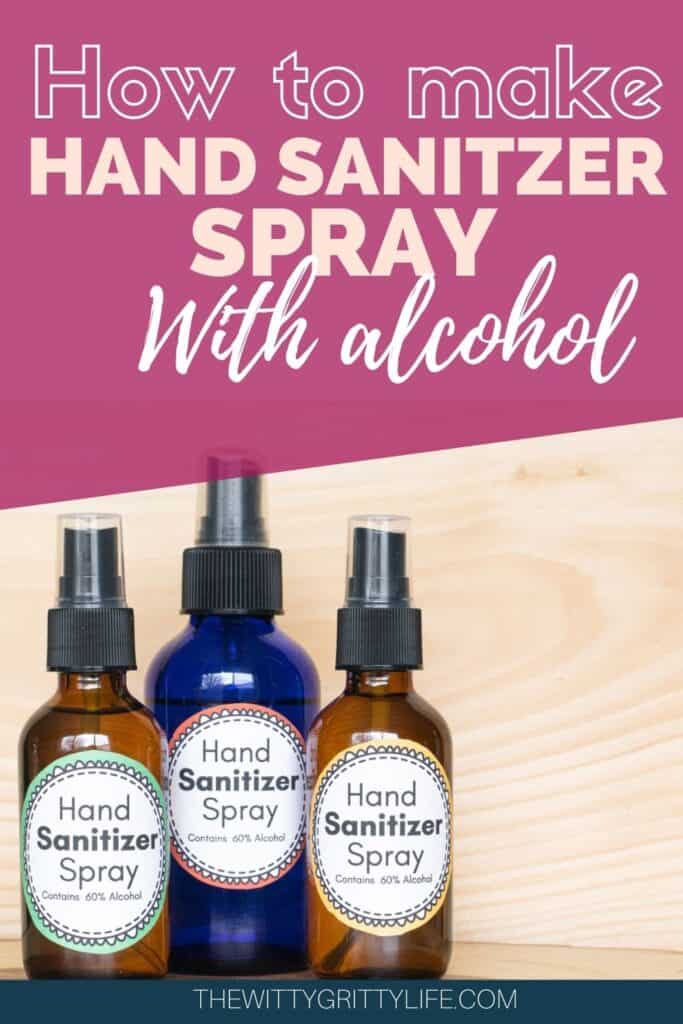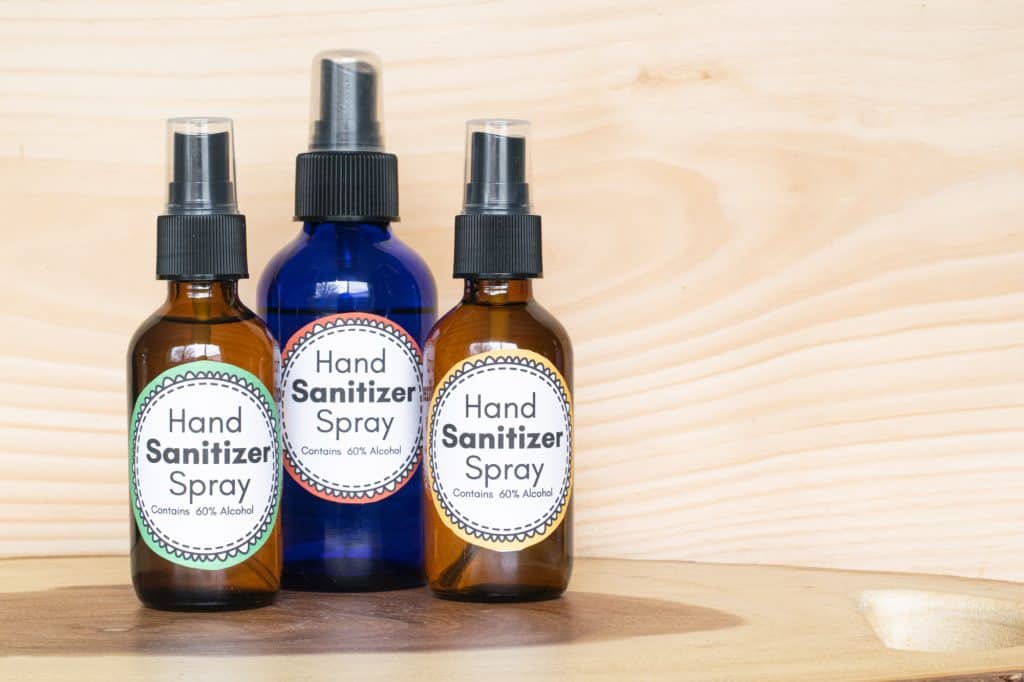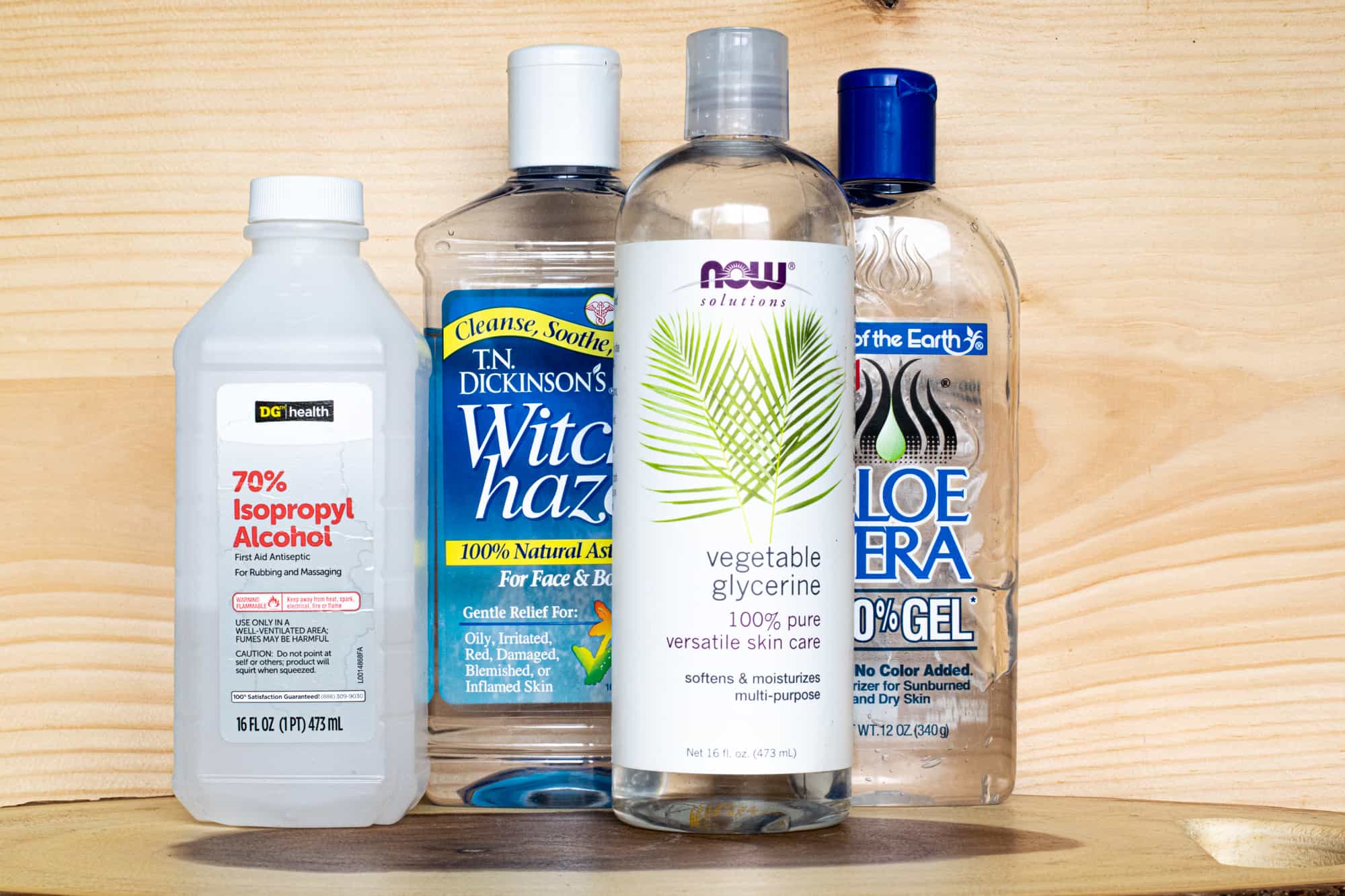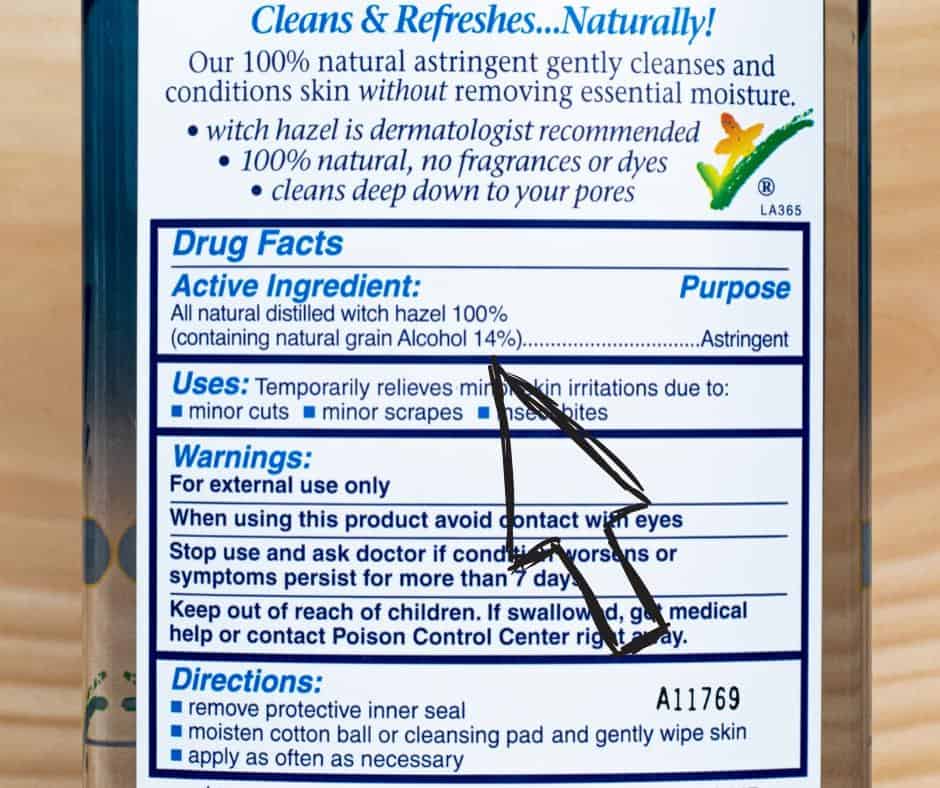Aloe vera gel-based hand sanitizer with essential oils is my normal go-to for hand cleaning when I’m out and about and don’t have access to a sink. But there are times when alcohol-based hand sanitizer spray just makes more sense. During the flu and cold season, I like to use a combination of both, an alcohol-based spray, followed by my gentle and skin-friendly gel sanitizer.
While it does a great job of keeping germs at bay, alcohol can have a very drying effect on the skin, which may lead to cracked, irritated hands, putting them at risk for infection. That is why it is important for you to give your hands a little extra TLC and the aloe vera gel-based sanitizer does the trick along with regular moisturizing.
An added benefit of an alcohol-based spray is that it can be used on surfaces like door handles and toilet seats if need be. That is something you would never want to try with a gel-based hand sanitizer!
Disclaimer: None of the information presented in this post is to be taken as medical advice or substitute for such. Always consult with your healthcare provider if you have questions regarding the use of sanitizing products. This product is intended for casual cleaning purposes and makes no claim to contain antiviral or antibacterial properties. Keep this product out of the reach of children as ingestion can cause grave harm. Use with caution, especially in the presence of small children and animals. Hand sanitizer products do not replace proper handwashing with soap and water. Learn how to wash your hands at CDC.gov.

* This post contains affiliate links. If you make a purchase by clicking on an affiliate link, I may earn a small commission at absolutely no additional cost to you. You can view my complete affiliate link policy HERE.

HOW TO MAKE ALCOHOL BASED HAND SANITIZER SPRAY
To ensure that hand sanitizer spray is actually effective, the CDC recommends a formulation that has an alcohol content of at least 60%. That was one of my main considerations when creating this recipe. For simplicity’s sake, I stuck with basic, readily available ingredients. You may already have everything on hand that is needed for this spray. It is important to use very exact measurements to maintain the proper percentage of alcohol.
SPECIAL CONSIDERATIONS
When creating hand sanitizer spray, keep in mind that the high alcohol content carries the risk of being flammable as well as that of accidental ingestion which can lead to alcohol poisoning. Always keep an alcohol-based hand sanitizer spray formulation in a safe place and make sure that if you are using it with children that you do so in a safe manner, speak under close and careful supervision. Be sure to clearly label the contents of the bottle! Keep the number to the Poison Control Center on hand at all times.
Before I go on I want to let you know that you can find this and many more of my homemade recipes for cleaning as handy printables in my FREE Resource Library. For this particular post, I also included pretty labels you can print out and label your handmade hand sanitizer spray.
THE BEST HAND SANITIZER SPRAY INGREDIENTS
Any time I create a recipe the main focus is on using the most effective ingredients, nothing less, nothing more. This formulation is no different. Since I have been making my own cleaning supplies as well as many skin and body care products for a long time, I generally have everything on hand. Let’s take a closer look at what I landed on for this recipe and why.

WHICH ALCOHOL IS BEST FOR SANITIZER?
Not all alcohols are the same. The most popular and widely available choices are Isopropyl (Rubbing) Alcohol and Ethyl Alcohol – Vodka.
Because it is considerably cheaper and very effective this recipe uses Isopropyl alcohol. While it can be found with 70% ABV (alcohol per volume), most vodka hovers around 40% ABV and the amount needed would be much greater to achieve the 60% benchmark that is recommended for alcohol-based hand sanitizer. Save your good vodka for a nice bloody Mary!
Isopropyl alcohol is usually readily available and is found in 70% and 91% and 99% concentrations. While one would think that a higher percentage of alcohol would mean greater disinfecting power, the opposite is actually the case. As it turns out the 70% concentration is the more effective bactericidal.
The 70% number refers to the total amount of alcohol per volume just as it does in any other type of alcohol. The presence of 30% water in this strength of rubbing alcohol is vital. It acts as a catalyst and slows evaporation. The slower evaporation time increases the time the sanitizing solution is in contact with the surface, giving it more time to do its job of killing germs.
The lower 70% concentration is also less volatile with a decreased risk of exposure to fumes as well as an explosion. Just remember that regardless of strength, the ingestion of Isopropyl Alcohol can be fatal.
What to do if you cannot find any 70% isopropyl alcohol
Can you dilute 91% or 99% alcohol to achieve the proper solution? The answer is yes – but you need to follow the exact amounts and ratios required to a T. To help you do this the right way I found this helpful article that explains the proper way to dilute 99% alcohol for use in hand sanitizer. Generally, 99% is easier to find when 70% is unavailable.
Why add witch hazel?
Witch hazel (Hamamelis) is an astringent often used as a facial toner. In the United States, witch hazel is regulated as an over-the-counter (OTC) drug for soothing minor skin irritations. You can learn more about it here.
In this recipe, witch hazel is used for its skin-soothing properties as well as a dispersant allowing the hand sanitizer to spray evenly and/or to remain dispersed in the air slightly longer.
Witch hazel is sold at any drug store or stores like Walmart and Target and is available in organic formulations. It contains 14% ABV, which was figured into this recipe. If you opt for alcohol-free witch hazel, know that it will put this recipe below the recommended 60% of total volume alcohol content. I recommend sticking to the kind with alcohol for this application.

Glycerine
Glycerin(e), also known as glycerol is an odorless syrupy liquid with a mild sweet taste. It is widely used in the cosmetic and food industry. It is included in this recipe for its moisturizing emollient properties as well as to thicken the solution slightly.
Glycerine is available at any health food store. It is derived from soybeans, coconut or palm oils. The source may not be shown on the label. If you have sensitivities to soy or palm products, be sure to use glycerine that does not include the ingredient you are avoiding.
Aloe Vera gel
You may use Aloe Vera interchangeably with glycerine in this recipe. Both share very similar properties with Aloe Vera being more of a gel consistency. Both Aloe Vera and Glycerine have a number of useful applications and if you are interested in creating your own skincare products, they are worthwhile having around!
Essential Oils
This recipe also includes essential oils, many of which have been used for their antibacterial as well as skin-soothing properties for hundreds of years. You can find my favorite high-quality sources for essential oils here.
Alcohol-based Hand Sanitizer Recipe
For this recipe combine:
- 1 1/2 cups (360ml) 70% Isopropyl Alcohol
- 1/4 cup (60ml) witch hazel, 14% alcohol content
- 1 TBS (15ml) glycerine or aloe vera gel
- 25 drops Thieves blend essential oil or 10 drops tea tree (melaleuca), 10 drops rosemary and 5 drops lavender essential oils
To use:
Liberally spray your hands with sanitizer solution and rub in until hands are dry. Spray surfaces and allow sanitizer to dry completely for maximum efficiency.
This recipe makes a total of 14 oz (415ml). You can fill it in different size spray bottles. I like keeping a 4 oz bottle at home as a quick disinfectant for spraying countertops and faucets. 2 oz bottles are a very convenient size to keep in your purse or your car.
They are available as colorful plastic (designate a different color for each family member!) or as colored glass bottles. You can even fit empty 15 ml essential oil bottles with small sprayers as a lightweight little spray that fits just about anywhere. Reuse your spray bottles again and again!
As I mentioned above, I like to keep a bottle for alcohol-based hand sanitizer spray AND a tube of my alcohol-free hand sanitizer gel handy. These reuseable silicone tubes are perfect for that!
Don’t forget to grab your bottle labels from the FREE Resource Library! I created two different size labels that should fit pretty much any bottle. They are my free gift to you. Using 8 1/2 glossy label sheets allows you to print out any size label you want without being tied to a specific template and you can use them for all kinds of other labeling duties.
For other useful recipes, among them my favorite and super easy hand balm recipe to keep your frequently washed and sanitized hands happy, check out these posts!
HOW TO MAKE ORGANIC LIP AND HAND BALM
EASY AND AFFORDABLE SKINCARE YOU CAN MAKE IN A SNAP
THREE EASY AND LUXURIOUS GIFTS YOU CAN MAKE IN NO TIME




Great information. We need all the help we can get during this awful time of the corona virus. TFS
Thank you! I hope you and your family won’t have to go through getting sick from this! Let’s hope it’s all over soon.
Thanks so much for all the extra knowledge on why and how etc. instead of just the recipe which was already a gift. Refilling my sons favorite clip on (to his lunchbox) hand sanitizer spray bottle. I was so close to listening to my husband and mixing more alcohol w the gel I already have. So you probably saved at least one life by posting this incredible information for us. Short sweet simple it’s perfect. Thanks again
You are so welcome!